Effective Change Management: Strategies and Implementation Issues
VerifiedAdded on 2023/06/15
|7
|1245
|475
Essay
AI Summary
This essay explores the multifaceted aspects of change management within organizations. It begins by defining organizational change, highlighting the internal and external pressures that drive it, such as new technologies, economic conditions, and consumer demands. The essay emphasizes the necessity for contemporary organizations to adapt to volatile business environments to maintain competitiveness, focusing on the evolution of new technologies and the empowerment of employees through decentralized decision-making. It delves into the reasons for the failure or under-achievement of change programs, citing issues like poor communication, lack of support, and inadequate resource allocation. Furthermore, the essay discusses the importance of continuous improvement and a structured approach to planning and management for successful change implementation. The document concludes by underscoring the critical role of leadership and employee training in ensuring the effective adoption and monitoring of changes within the organization.

Running head: MANAGEMENT OF CHANGE
Management of Change
Name of the Student:
Name of the University:
Author Note:
Management of Change
Name of the Student:
Name of the University:
Author Note:
Paraphrase This Document
Need a fresh take? Get an instant paraphrase of this document with our AI Paraphraser
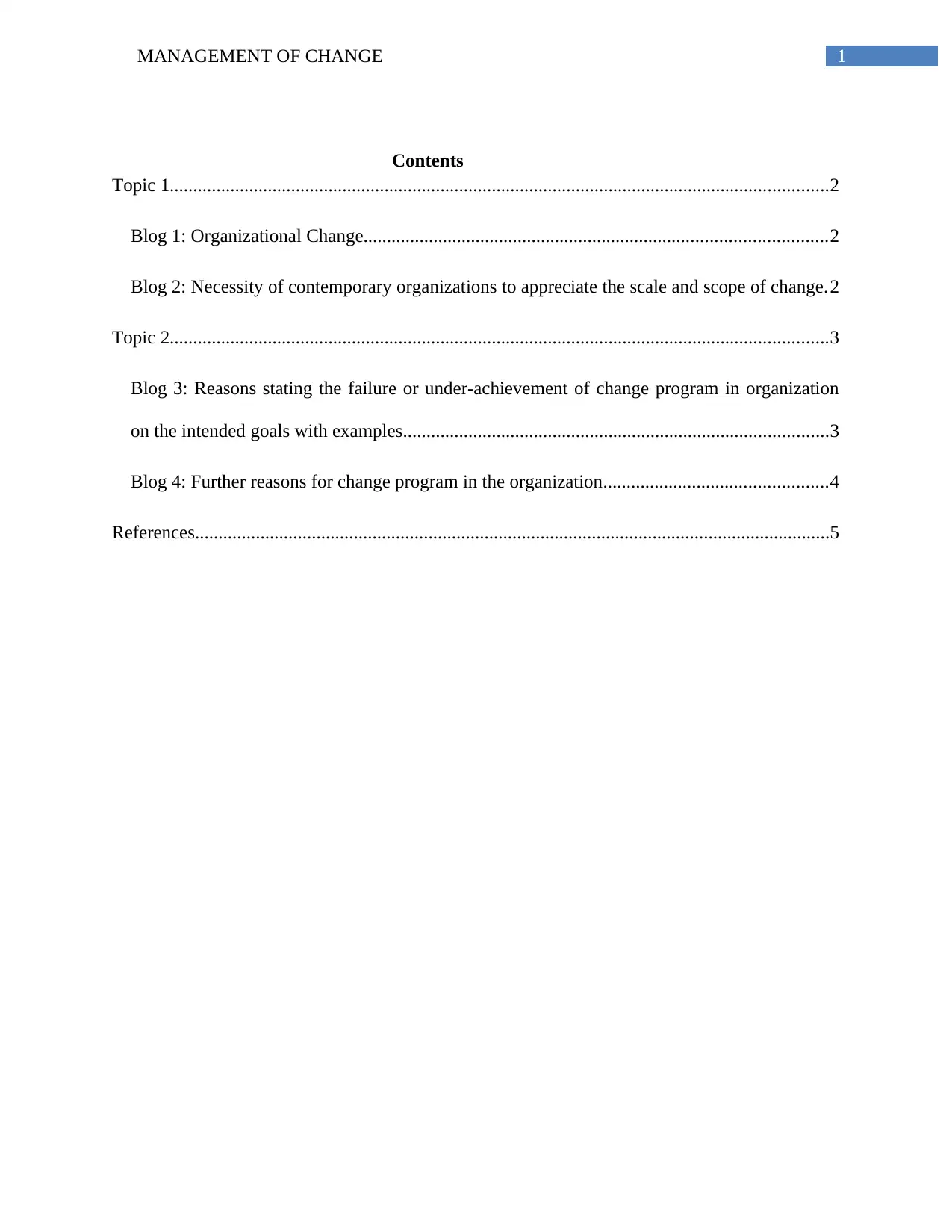
1MANAGEMENT OF CHANGE
Contents
Topic 1.............................................................................................................................................2
Blog 1: Organizational Change...................................................................................................2
Blog 2: Necessity of contemporary organizations to appreciate the scale and scope of change.2
Topic 2.............................................................................................................................................3
Blog 3: Reasons stating the failure or under-achievement of change program in organization
on the intended goals with examples...........................................................................................3
Blog 4: Further reasons for change program in the organization................................................4
References........................................................................................................................................5
Contents
Topic 1.............................................................................................................................................2
Blog 1: Organizational Change...................................................................................................2
Blog 2: Necessity of contemporary organizations to appreciate the scale and scope of change.2
Topic 2.............................................................................................................................................3
Blog 3: Reasons stating the failure or under-achievement of change program in organization
on the intended goals with examples...........................................................................................3
Blog 4: Further reasons for change program in the organization................................................4
References........................................................................................................................................5
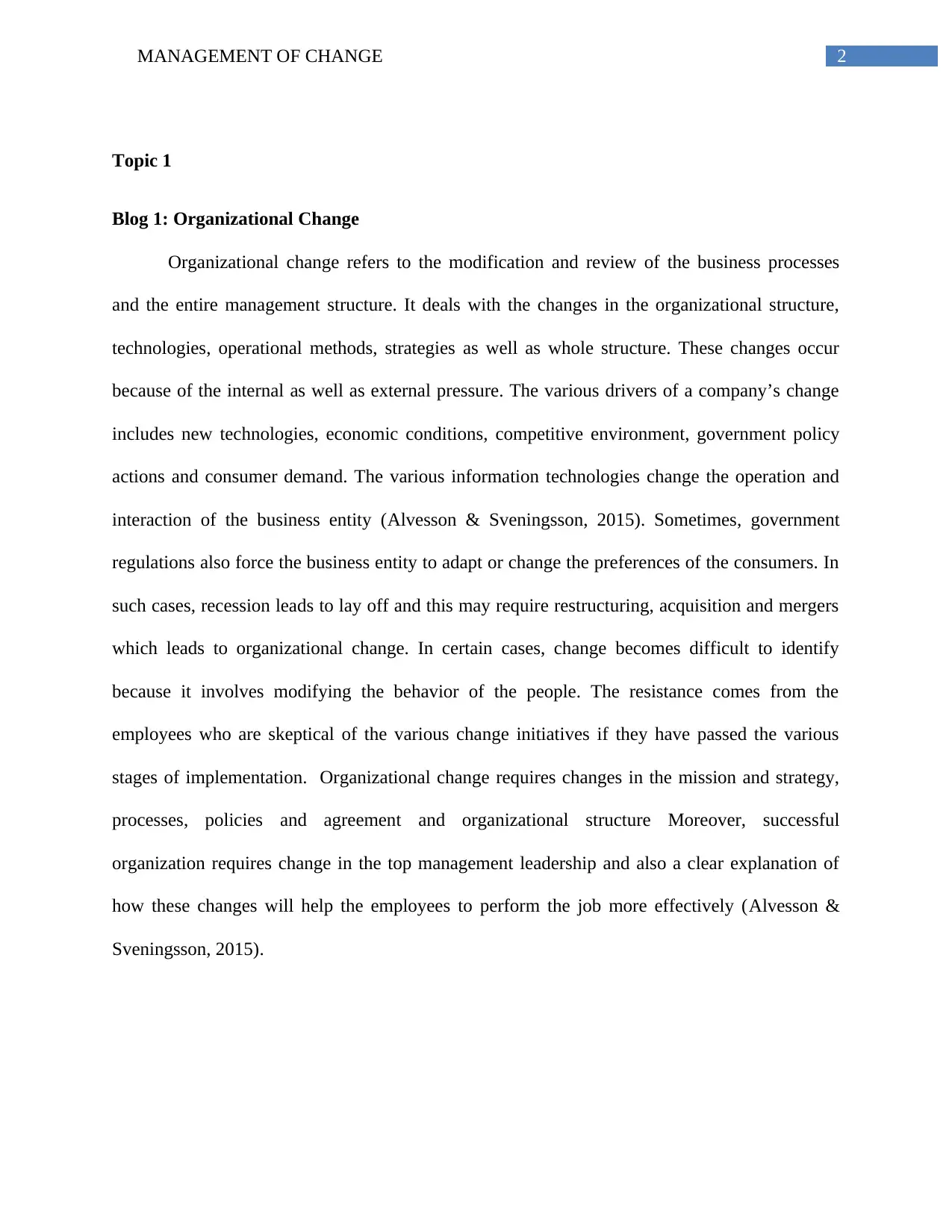
2MANAGEMENT OF CHANGE
Topic 1
Blog 1: Organizational Change
Organizational change refers to the modification and review of the business processes
and the entire management structure. It deals with the changes in the organizational structure,
technologies, operational methods, strategies as well as whole structure. These changes occur
because of the internal as well as external pressure. The various drivers of a company’s change
includes new technologies, economic conditions, competitive environment, government policy
actions and consumer demand. The various information technologies change the operation and
interaction of the business entity (Alvesson & Sveningsson, 2015). Sometimes, government
regulations also force the business entity to adapt or change the preferences of the consumers. In
such cases, recession leads to lay off and this may require restructuring, acquisition and mergers
which leads to organizational change. In certain cases, change becomes difficult to identify
because it involves modifying the behavior of the people. The resistance comes from the
employees who are skeptical of the various change initiatives if they have passed the various
stages of implementation. Organizational change requires changes in the mission and strategy,
processes, policies and agreement and organizational structure Moreover, successful
organization requires change in the top management leadership and also a clear explanation of
how these changes will help the employees to perform the job more effectively (Alvesson &
Sveningsson, 2015).
Topic 1
Blog 1: Organizational Change
Organizational change refers to the modification and review of the business processes
and the entire management structure. It deals with the changes in the organizational structure,
technologies, operational methods, strategies as well as whole structure. These changes occur
because of the internal as well as external pressure. The various drivers of a company’s change
includes new technologies, economic conditions, competitive environment, government policy
actions and consumer demand. The various information technologies change the operation and
interaction of the business entity (Alvesson & Sveningsson, 2015). Sometimes, government
regulations also force the business entity to adapt or change the preferences of the consumers. In
such cases, recession leads to lay off and this may require restructuring, acquisition and mergers
which leads to organizational change. In certain cases, change becomes difficult to identify
because it involves modifying the behavior of the people. The resistance comes from the
employees who are skeptical of the various change initiatives if they have passed the various
stages of implementation. Organizational change requires changes in the mission and strategy,
processes, policies and agreement and organizational structure Moreover, successful
organization requires change in the top management leadership and also a clear explanation of
how these changes will help the employees to perform the job more effectively (Alvesson &
Sveningsson, 2015).
⊘ This is a preview!⊘
Do you want full access?
Subscribe today to unlock all pages.

Trusted by 1+ million students worldwide
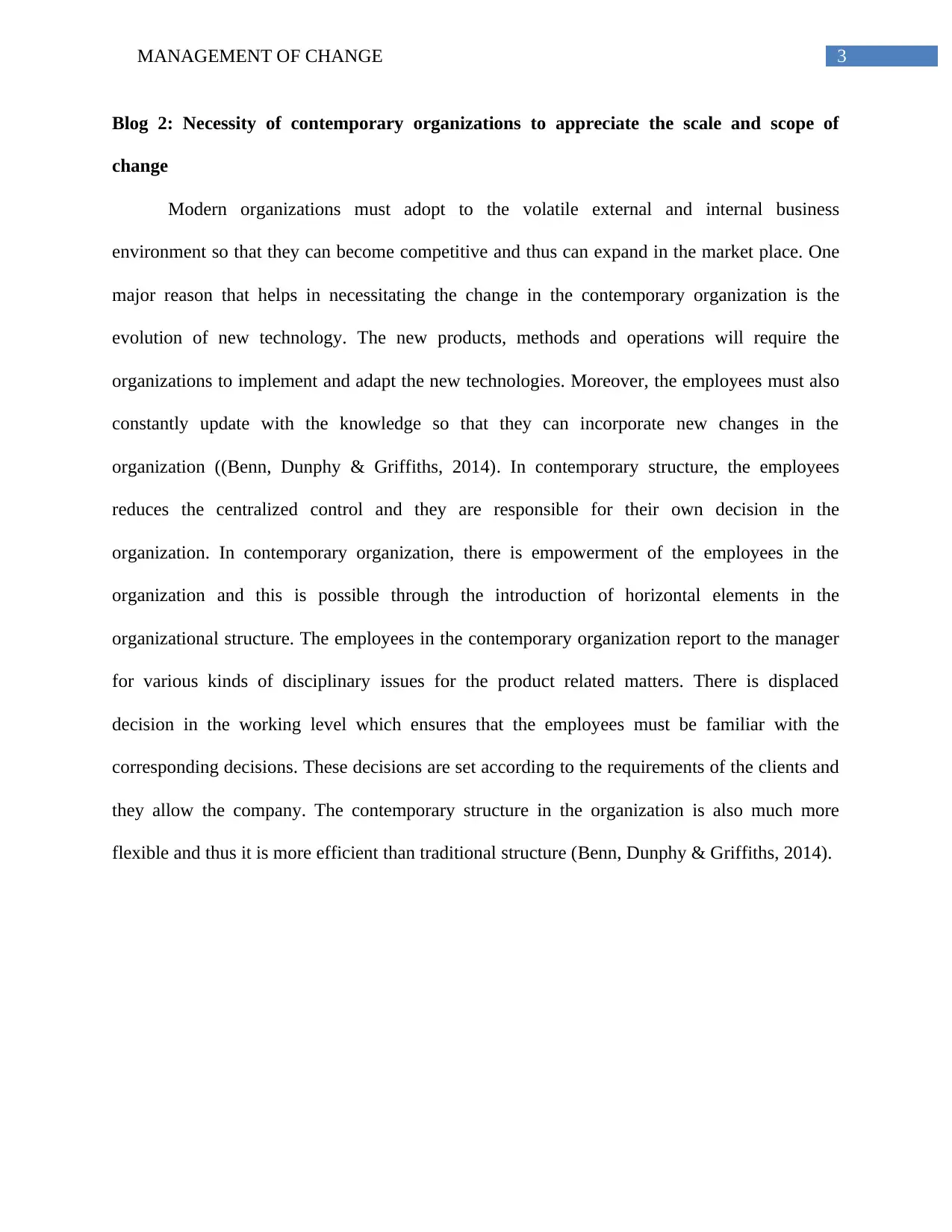
3MANAGEMENT OF CHANGE
Blog 2: Necessity of contemporary organizations to appreciate the scale and scope of
change
Modern organizations must adopt to the volatile external and internal business
environment so that they can become competitive and thus can expand in the market place. One
major reason that helps in necessitating the change in the contemporary organization is the
evolution of new technology. The new products, methods and operations will require the
organizations to implement and adapt the new technologies. Moreover, the employees must also
constantly update with the knowledge so that they can incorporate new changes in the
organization ((Benn, Dunphy & Griffiths, 2014). In contemporary structure, the employees
reduces the centralized control and they are responsible for their own decision in the
organization. In contemporary organization, there is empowerment of the employees in the
organization and this is possible through the introduction of horizontal elements in the
organizational structure. The employees in the contemporary organization report to the manager
for various kinds of disciplinary issues for the product related matters. There is displaced
decision in the working level which ensures that the employees must be familiar with the
corresponding decisions. These decisions are set according to the requirements of the clients and
they allow the company. The contemporary structure in the organization is also much more
flexible and thus it is more efficient than traditional structure (Benn, Dunphy & Griffiths, 2014).
Blog 2: Necessity of contemporary organizations to appreciate the scale and scope of
change
Modern organizations must adopt to the volatile external and internal business
environment so that they can become competitive and thus can expand in the market place. One
major reason that helps in necessitating the change in the contemporary organization is the
evolution of new technology. The new products, methods and operations will require the
organizations to implement and adapt the new technologies. Moreover, the employees must also
constantly update with the knowledge so that they can incorporate new changes in the
organization ((Benn, Dunphy & Griffiths, 2014). In contemporary structure, the employees
reduces the centralized control and they are responsible for their own decision in the
organization. In contemporary organization, there is empowerment of the employees in the
organization and this is possible through the introduction of horizontal elements in the
organizational structure. The employees in the contemporary organization report to the manager
for various kinds of disciplinary issues for the product related matters. There is displaced
decision in the working level which ensures that the employees must be familiar with the
corresponding decisions. These decisions are set according to the requirements of the clients and
they allow the company. The contemporary structure in the organization is also much more
flexible and thus it is more efficient than traditional structure (Benn, Dunphy & Griffiths, 2014).
Paraphrase This Document
Need a fresh take? Get an instant paraphrase of this document with our AI Paraphraser
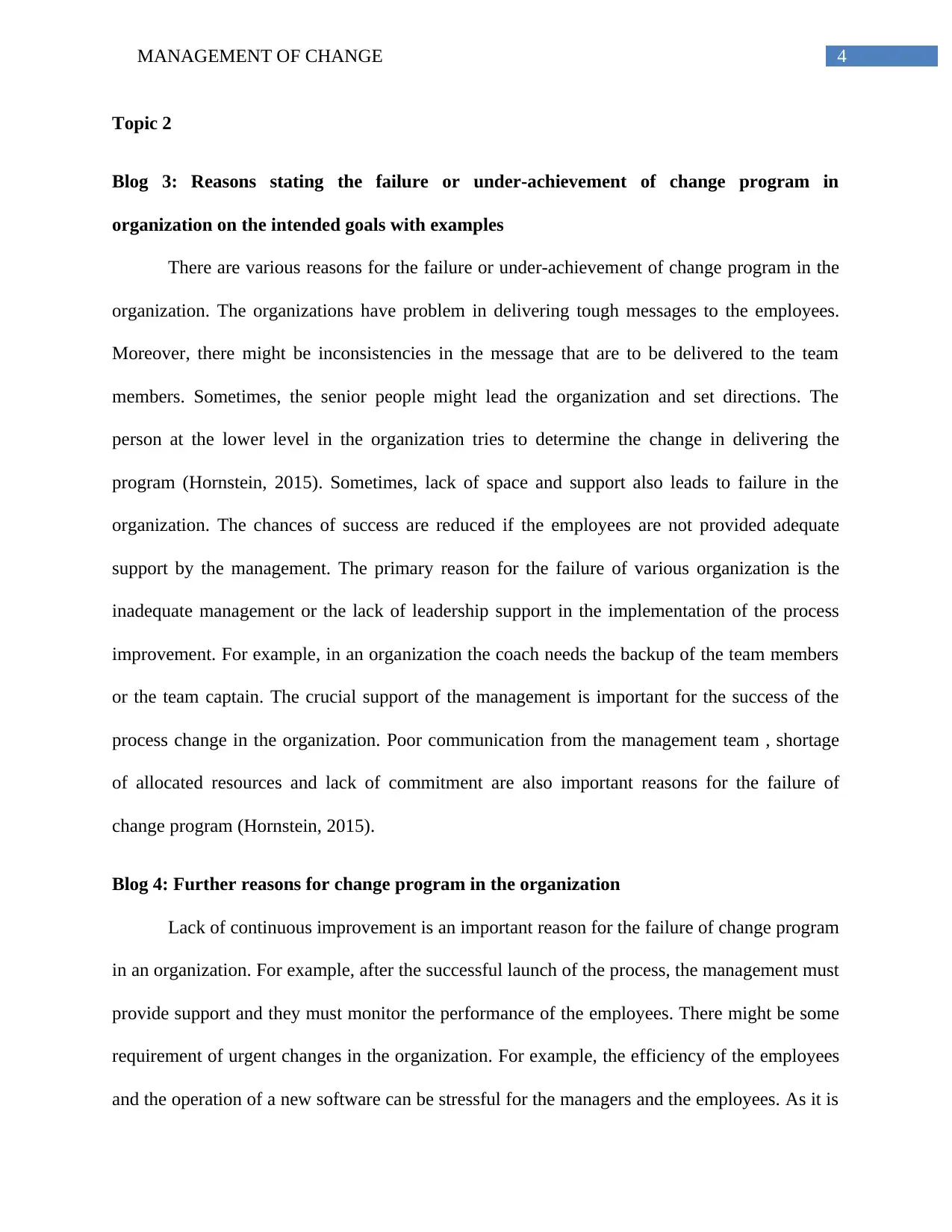
4MANAGEMENT OF CHANGE
Topic 2
Blog 3: Reasons stating the failure or under-achievement of change program in
organization on the intended goals with examples
There are various reasons for the failure or under-achievement of change program in the
organization. The organizations have problem in delivering tough messages to the employees.
Moreover, there might be inconsistencies in the message that are to be delivered to the team
members. Sometimes, the senior people might lead the organization and set directions. The
person at the lower level in the organization tries to determine the change in delivering the
program (Hornstein, 2015). Sometimes, lack of space and support also leads to failure in the
organization. The chances of success are reduced if the employees are not provided adequate
support by the management. The primary reason for the failure of various organization is the
inadequate management or the lack of leadership support in the implementation of the process
improvement. For example, in an organization the coach needs the backup of the team members
or the team captain. The crucial support of the management is important for the success of the
process change in the organization. Poor communication from the management team , shortage
of allocated resources and lack of commitment are also important reasons for the failure of
change program (Hornstein, 2015).
Blog 4: Further reasons for change program in the organization
Lack of continuous improvement is an important reason for the failure of change program
in an organization. For example, after the successful launch of the process, the management must
provide support and they must monitor the performance of the employees. There might be some
requirement of urgent changes in the organization. For example, the efficiency of the employees
and the operation of a new software can be stressful for the managers and the employees. As it is
Topic 2
Blog 3: Reasons stating the failure or under-achievement of change program in
organization on the intended goals with examples
There are various reasons for the failure or under-achievement of change program in the
organization. The organizations have problem in delivering tough messages to the employees.
Moreover, there might be inconsistencies in the message that are to be delivered to the team
members. Sometimes, the senior people might lead the organization and set directions. The
person at the lower level in the organization tries to determine the change in delivering the
program (Hornstein, 2015). Sometimes, lack of space and support also leads to failure in the
organization. The chances of success are reduced if the employees are not provided adequate
support by the management. The primary reason for the failure of various organization is the
inadequate management or the lack of leadership support in the implementation of the process
improvement. For example, in an organization the coach needs the backup of the team members
or the team captain. The crucial support of the management is important for the success of the
process change in the organization. Poor communication from the management team , shortage
of allocated resources and lack of commitment are also important reasons for the failure of
change program (Hornstein, 2015).
Blog 4: Further reasons for change program in the organization
Lack of continuous improvement is an important reason for the failure of change program
in an organization. For example, after the successful launch of the process, the management must
provide support and they must monitor the performance of the employees. There might be some
requirement of urgent changes in the organization. For example, the efficiency of the employees
and the operation of a new software can be stressful for the managers and the employees. As it is
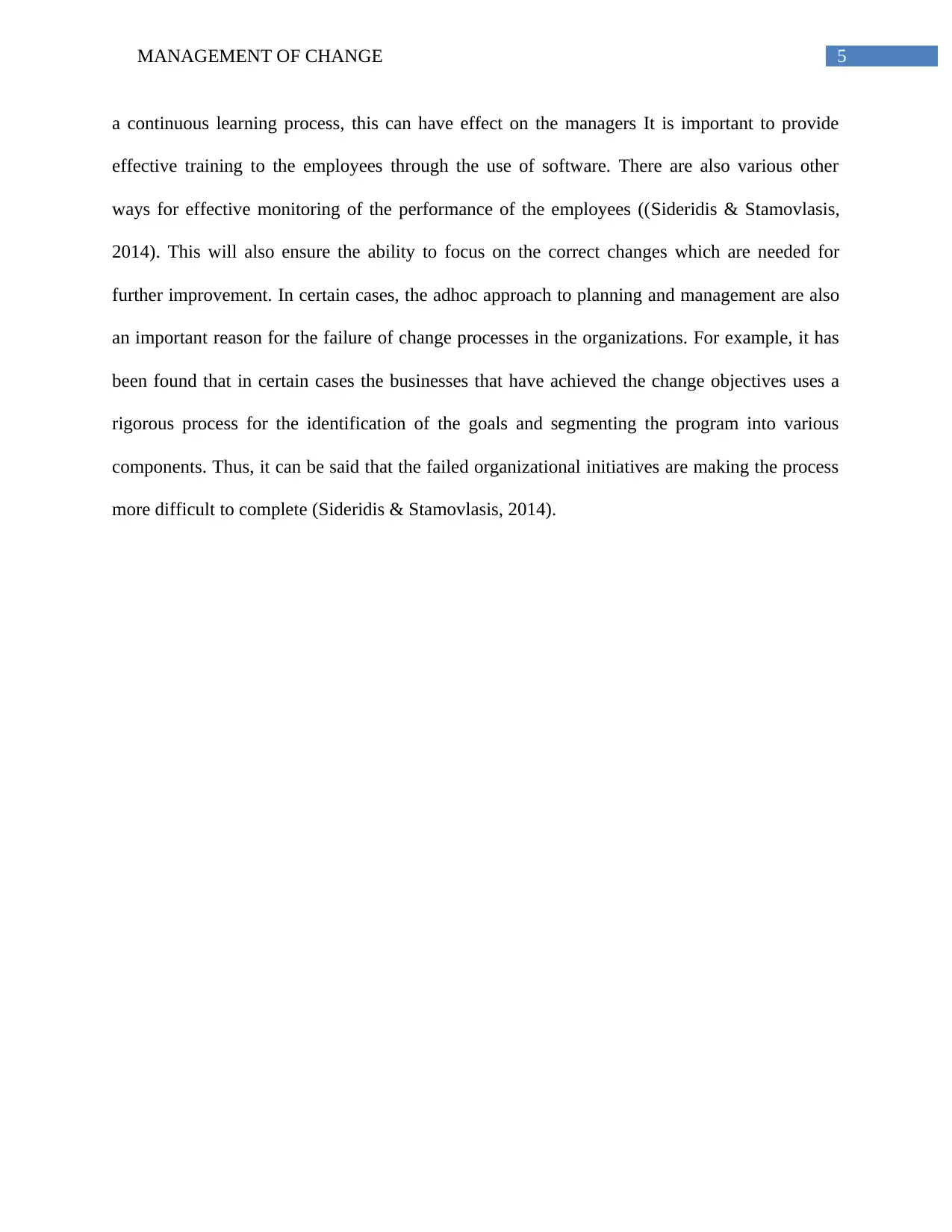
5MANAGEMENT OF CHANGE
a continuous learning process, this can have effect on the managers It is important to provide
effective training to the employees through the use of software. There are also various other
ways for effective monitoring of the performance of the employees ((Sideridis & Stamovlasis,
2014). This will also ensure the ability to focus on the correct changes which are needed for
further improvement. In certain cases, the adhoc approach to planning and management are also
an important reason for the failure of change processes in the organizations. For example, it has
been found that in certain cases the businesses that have achieved the change objectives uses a
rigorous process for the identification of the goals and segmenting the program into various
components. Thus, it can be said that the failed organizational initiatives are making the process
more difficult to complete (Sideridis & Stamovlasis, 2014).
a continuous learning process, this can have effect on the managers It is important to provide
effective training to the employees through the use of software. There are also various other
ways for effective monitoring of the performance of the employees ((Sideridis & Stamovlasis,
2014). This will also ensure the ability to focus on the correct changes which are needed for
further improvement. In certain cases, the adhoc approach to planning and management are also
an important reason for the failure of change processes in the organizations. For example, it has
been found that in certain cases the businesses that have achieved the change objectives uses a
rigorous process for the identification of the goals and segmenting the program into various
components. Thus, it can be said that the failed organizational initiatives are making the process
more difficult to complete (Sideridis & Stamovlasis, 2014).
⊘ This is a preview!⊘
Do you want full access?
Subscribe today to unlock all pages.

Trusted by 1+ million students worldwide
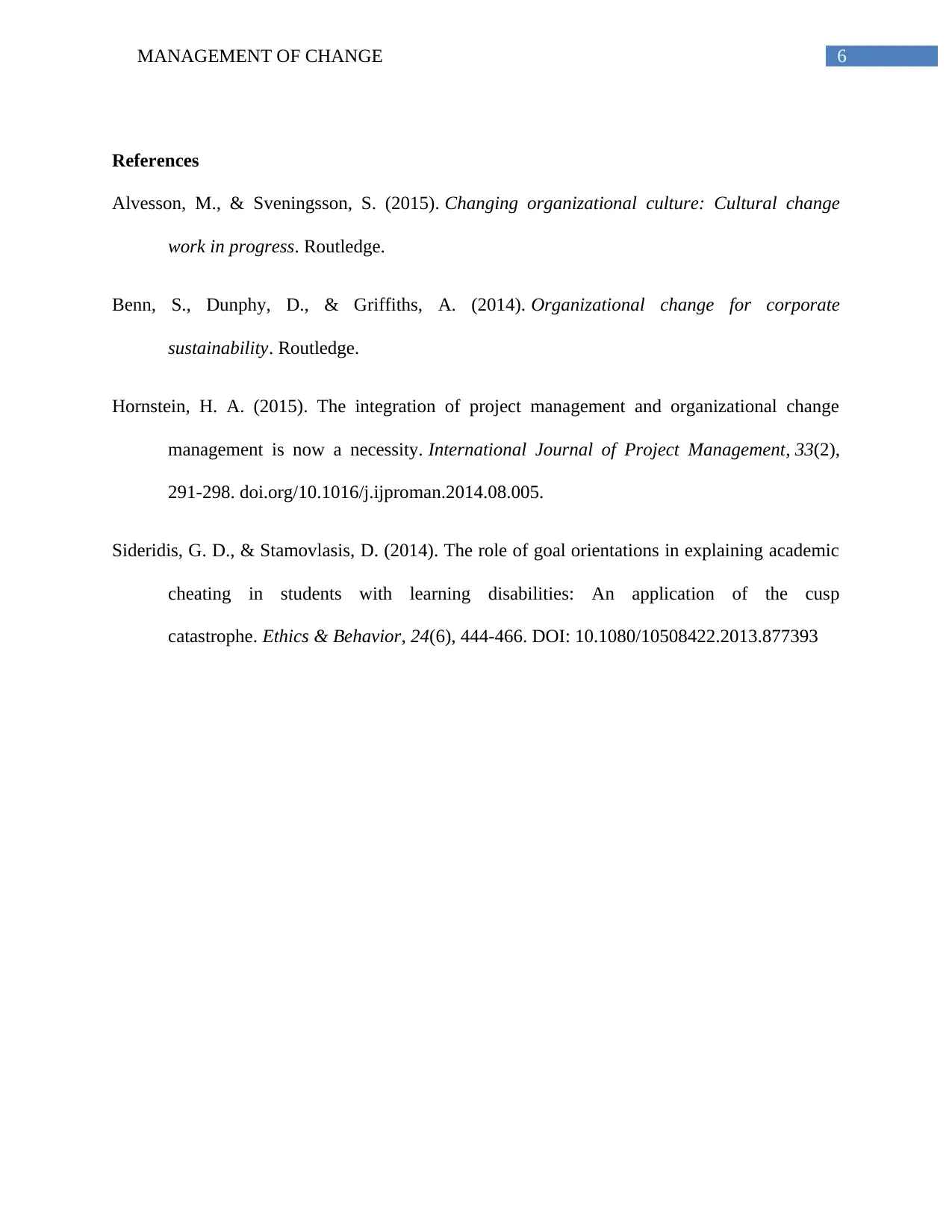
6MANAGEMENT OF CHANGE
References
Alvesson, M., & Sveningsson, S. (2015). Changing organizational culture: Cultural change
work in progress. Routledge.
Benn, S., Dunphy, D., & Griffiths, A. (2014). Organizational change for corporate
sustainability. Routledge.
Hornstein, H. A. (2015). The integration of project management and organizational change
management is now a necessity. International Journal of Project Management, 33(2),
291-298. doi.org/10.1016/j.ijproman.2014.08.005.
Sideridis, G. D., & Stamovlasis, D. (2014). The role of goal orientations in explaining academic
cheating in students with learning disabilities: An application of the cusp
catastrophe. Ethics & Behavior, 24(6), 444-466. DOI: 10.1080/10508422.2013.877393
References
Alvesson, M., & Sveningsson, S. (2015). Changing organizational culture: Cultural change
work in progress. Routledge.
Benn, S., Dunphy, D., & Griffiths, A. (2014). Organizational change for corporate
sustainability. Routledge.
Hornstein, H. A. (2015). The integration of project management and organizational change
management is now a necessity. International Journal of Project Management, 33(2),
291-298. doi.org/10.1016/j.ijproman.2014.08.005.
Sideridis, G. D., & Stamovlasis, D. (2014). The role of goal orientations in explaining academic
cheating in students with learning disabilities: An application of the cusp
catastrophe. Ethics & Behavior, 24(6), 444-466. DOI: 10.1080/10508422.2013.877393
1 out of 7
Related Documents
Your All-in-One AI-Powered Toolkit for Academic Success.
+13062052269
info@desklib.com
Available 24*7 on WhatsApp / Email
![[object Object]](/_next/static/media/star-bottom.7253800d.svg)
Unlock your academic potential
Copyright © 2020–2025 A2Z Services. All Rights Reserved. Developed and managed by ZUCOL.



